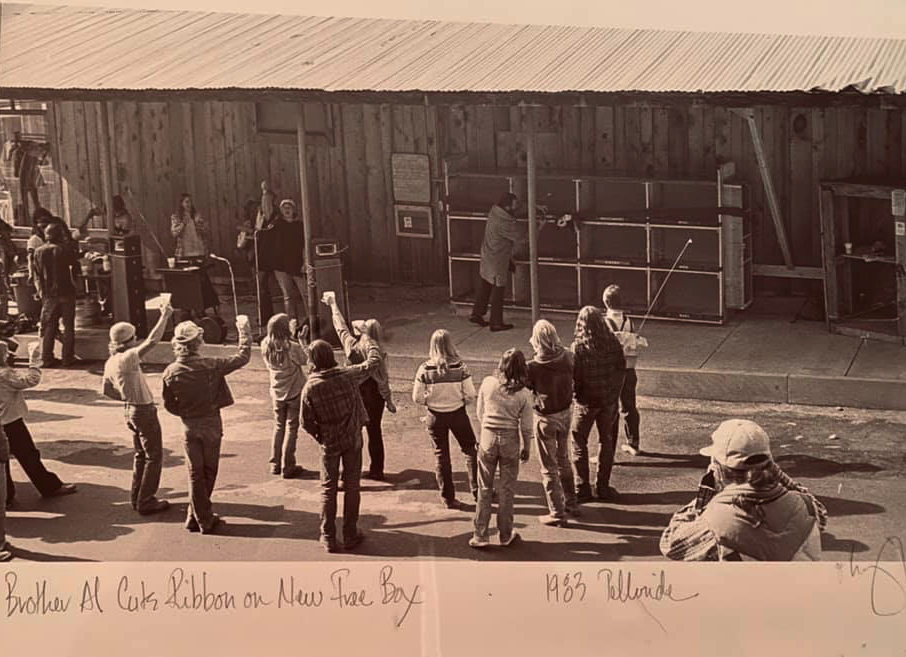Mahoney was born in Bonanza, Colorado, but moved to Telluride with his family in 1930, when he was 2-years old.
Before long, he was on skis. In the Telluride Historical Museum’s 2009 film “We Skied It”, Mahoney shares how it all began.
“We just skied Oak Street, and got pulled behind cars. It was Depression time, and nobody had any equipment,” said Mahoney, “I remember my dad bought me a pair of skis for $15 from Spiggles and they were made out of ash; and of course skis in those days did not have binders, just a leather strap.”
Mahoney skied Firecracker Hill and Kid’s Hill (known as Grizzly Gulch at the time). But by the 60s he was heading into the backcountry.
“From Bridal Veil Basin, to La Junta Basin, to East Bear Creek, to the Blue Lakes over on Sneffels, to Imogine Pass, Governor Basin, you name it. If there was snow there, we would ski it,” he said.
And Mahoney passed that love of skiing and adventure onto his children.
“He’d go out there and he’d pack the snow down and we’d have our disks and sleds, and we’d ski on the street. He just had all this energy,” says William “Junior” Mahoney, Mahoney’s son. “Then we had the rope tow at Firecracker Hill. That’s where I learned. He was really good with all us kids, taking us skiing all the time, because quite frankly he was pretty much just a big kid all the time anyway.”
The rope tow at Firecracker Hill stands out to others who knew him as well. It’s where Stevens remembers first meeting Mahoney as a child.
“I think the first time I remember meeting him, when I was probably 7 or 8, and he’d go up there and start that little motor. It was on a toboggan, and it would pull one or two people and Billy, he’s the guy,” says Stevens.
But it wasn’t only skiing, Junior Mahoney says his dad’s love for the outdoors spread into the summer months as well.
“Every weekend we were either out hiking and prospecting. He loved to go out and look for gold, which he was really good at, and I’d go with him,” Junior Mahoney says, “he had so much energy and excitement. It’s hard to really describe it, but that’s who he was and I got to enjoy it.”
Senior Mahoney was instrumental in the creation of the Telluride Ski Resort, but it’s not where he started. At 15-years old, Mahoney began work at the Idarado Mine – loading buckets of ore from the aerial trams.
Stevens worked for Mahoney in the mine. By that time, Mahoney was one of the men in charge. Stevens remembers him looking out for the younger guys, giving them overtime, letting them work on the weekends to make more money.
“He loved mining more than skiing, he would tell you,” says Stevens. “That’s quite a statement. He was a miner; boy I’ll tell you that. He did it all.”
After high school, Mahoney joined the Navy, but returned to Telluride after two years abroad. He married his high school sweetheart, Twylla, and continued working in the mine, until he had the opportunity to join a group who were going to build a ski resort on the mountain. Junior Mahoney remembers the day his dad told the family.
“Dad came in and said, ‘well, I’ve got this opportunity to quit the mine and go to work to build a ski area’,” Junior Mahoney remembers, “my sister and I and my mom, we were all in the dining room of the house and it was dead quiet, because none of us knew what that was going to mean, of course. I know the thought that ran through my head was ‘the mine has been there forever, and it will be there forever. Is this a good thing or not?’ But he made the decision to do that and it was probably the best decision he ever made.”
Mahoney went to work on the resort. Joe Zoline had bought the property and slowly but surely runs and lifts started to go in.
“He was there every day, all day, and that was his life,” says Junior Mahoney, “he loved it. He loved every minute of it.”
Junior Mahoney says he saw his dad as the energy and enthusiasm that fueled the creation of the ski resort.
“He just totally believed, for years and years, that we had the mountain that could be a ski area. When the opportunity finally came. When Joe Zoline hired Dad, that was like the greatest day of his life almost,” says Junior Mahoney.
Mahoney brought vast knowledge of skiable terrain, starting as the mountain’s snowcat operations manager, later becoming Mountain Manager and Vice President of the Ski Resort before retiring in 1993. In 1997, Mahoney was inducted into the Colorado Ski Hall of Fame.
He is also the reason Stevens came back to Town after graduating from college. He got Stevens a job on the Mountain.
Stevens says, “I worked with him a lot of years on a lot of complex things, and he was always the most thoughtful, hardworking, logical, smart, visionary guy. He was a Renaissance man, no question.”
Stevens would go on to become Mountain Manager and Chief Operations Officer for the resort, and he knows the impact of Mahoney’s vision and work ethic.
“Billy Mahoney, and I give him 100% credit, he decided in 1959 to draw the line of the ski area to go up the front hillside, around Needle Rock, up to Gold Hill, up to Palmyra Peak – which was just wild, and then down to Bald Mountain,” says Stevens, “We wouldn’t be skiing any of that stuff, but for Billy Mahoney. No question.”
Senior Mahoney will keep an eye out on those runs he helped to create. Junior Mahoney says his dad requested to have some of his ashes spread on the peaks above the resort.
Mahoney is survived by his wife of more than 70 years, Twylla, his children, William and Mona, his grandchildren, James, Riley, and Brady, and his great-grandchildren Lilyann, Magnolia, and Harper.
In lieu of flowers, the Mahoney family is asking members of the community to make donations to the Telluride Ski and Snowboard Club.




























